Explorer Collection Installation Manual
Install Guide:
Introduction
Thank you for purchasing the Explorer Collection. The Explorer Collection of loudspeakers from Origin Acoustics were developed to withstand the harsh conditions found in marine environments. This includes exposure to saltwater, extreme temperature changes and airborne humidity. They will produce amazing musical fidelity while spending family time on the lake or a trip on the open sea and they have the build quality to last for years in these situations.
This instruction booklet covers the necessary information for a smooth installation, including: the tools you will need, step-by-step instructions for installation, troubleshooting tips for any errors that may occur, and all warranty information. If for any reason you experience problems or if you have installation questions please call us at (844) 674-4461. Hours of operation are 8:00am to 5:00pm (Pacific Time), Monday through Friday.
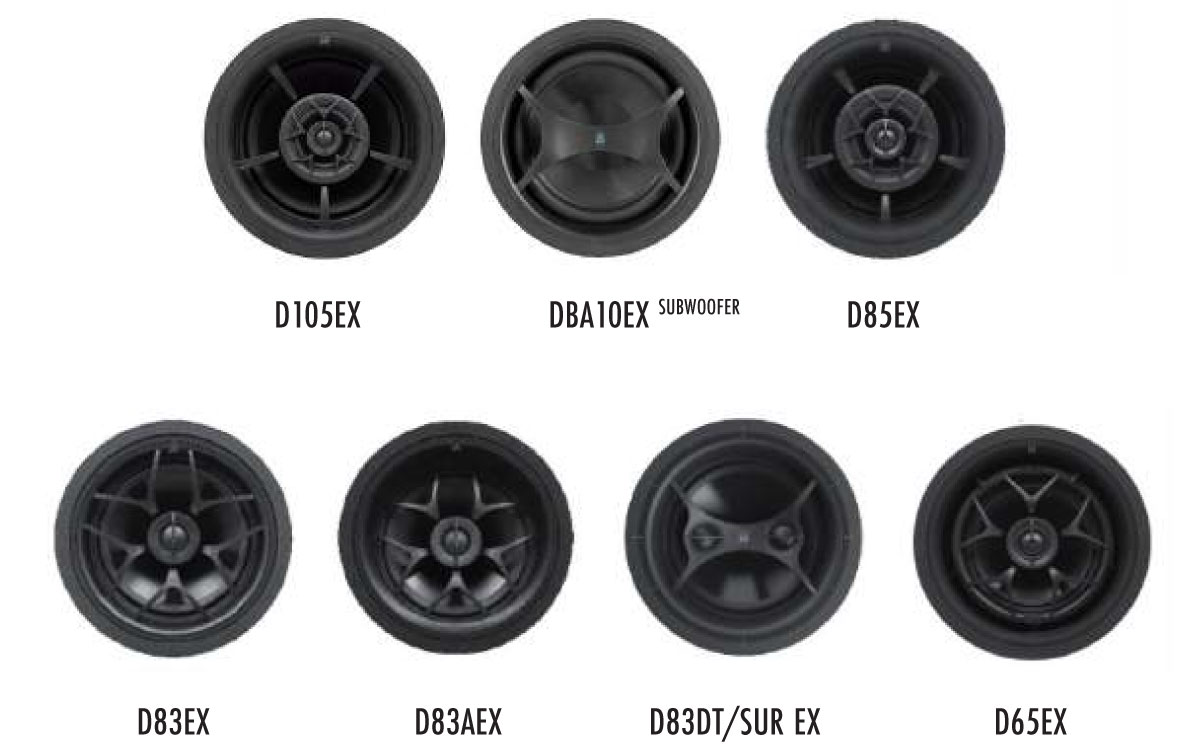
Notes
DUAL TWEETERS
The Dual Tweeter models can be used for either one channel (surround) or two channels (stereo). A switch is located on the back of the speaker to select which mode to use. One of the modes is labeled as “Dipole” for surround and the other as “Stereo”. In Dipole mode, you can connect the wire to either left or right input.
SURROUND (DIPOLE)
In this mode, one channel is fed into both tweeters to be distributed throughout the area. This way in a multiple-speaker setup, one speaker can be a dedicated left speaker and another a dedicated right.
STEREO
In this mode, two channels are fed into the speaker: one channel for each tweeter. This setup is ideal for small rooms such as walk-in closets and bathrooms, as well as oddly-shaped areas such as hallways. With both left and right channels in one speaker, only one speaker is needed in smaller rooms. In areas like hallways, both channels can be evenly distributed throughout the area with multiple speakers.
WARNING
If you are using a dual tweeter speaker in stereo mode (i.e. there are two wires connected to the speaker: one for the left channel and one for the right), do not set the switch to surround mode. This could damage the amplifier.
What's Included
Speaker
Bayonet Ring
Grille
Template
Installation Manual
Wire Recommendation
The gauge of wire used can have an impact on the performance of your speakers. Use a multi-stranded wiring designed for amplifier to speaker connections. Which gauge to select depends on the length of wire to be used on any particular speak–er. The longer your run is, the larger your wire size must be.
| WIRE LENGTH | WIRE GAUGE |
|---|---|
| 0 -100’ (0 - 30m) | 16 |
| 50 - 150’ (15 - 45m) | 14 |
| Over 100’ (30m) | 12 |
About Speaker Wire
Use a two conductor wire that allows you to identify one conductor from the other. This designation may be obvious or as subtle as a ridge on one conductor. It’s crucial that you keep track of which wire you use for positive (+) and negative (-). Typically if the wires are colored red and black, the red wire is used for positive and the black wire is used for negative, but sometimes other colors or patterns are used. You can choose whichever color of wire you want to be positive and negative as long as you remain consistent throughout the install. On both your amplifier and your speaker the connectors will be identified as red for positive and black for negative. It is very important to look carefully at the speaker wires and be certain that the same wire that is attached to the positive connector in the amplifier is attached to the positive connector in the speaker.
Auxiliary Room (2 Speaker Placement)
Ideally, the two speakers should be placed at an equal distance from the listener. If the room has a lower ceiling, the speakers can be closer together. Also, if the speaker placement is intended for standing (as opposed to sitting) listeners, the speakers can be closer together.
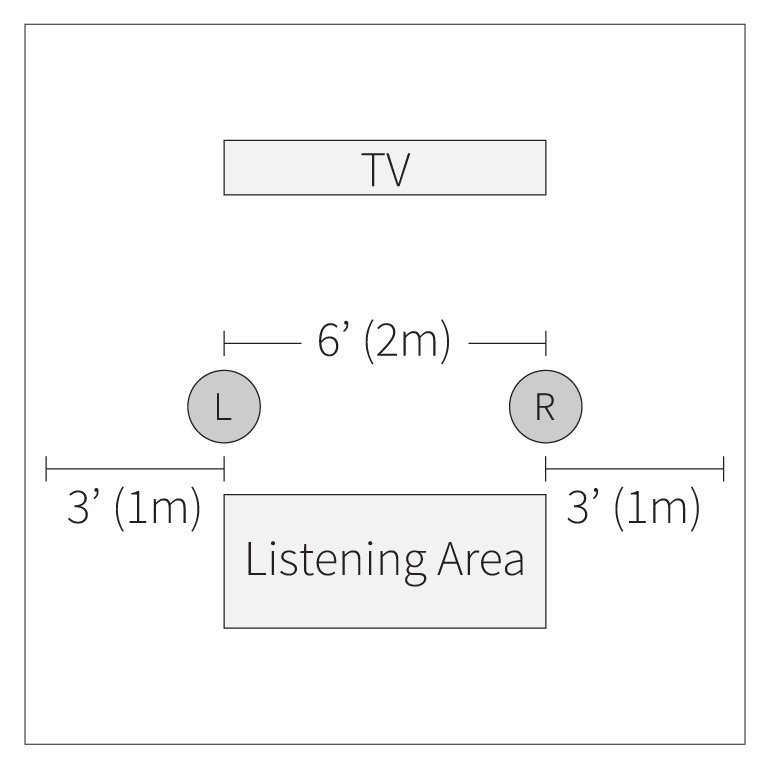
Home Theater (5 Speaker Placement)
The Left Rear (LR) and Right Rear (RR) speakers should be installed just behind the listener, one on either side. The Center Channel (CC) speaker should be placed above and slightly in front of the television, with the Left Front (LF) and Right Front (RF) speakers placed equidistant to either side.
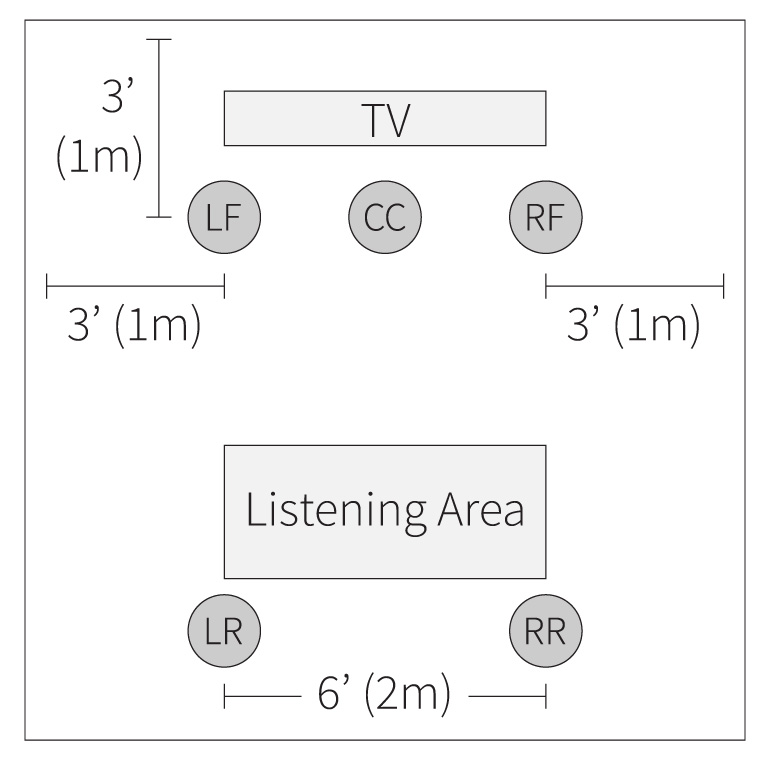
Installing the Wire
Strip ¼ to ½ inches (6 to 12 mm) of the insulation off both ends of the wire. To avoid stray strands, twist them at the end. Connect the wire to the amplifier, and make sure the wire connected to the left speaker output will be routed to the left speaker, right output to right speaker, etc.

Wire Routing
Plan how you will route the wire to the desired speaker location. There are several methods for routing the wire, and you may need to combine several of them.
Behind the Baseboard
The wire can be routed behind the baseboard by cutting a groove out of the back of the baseboard, or by buying a special baseboard designed for concealing wires.
Attic or Basement
When available, you can route the wire through an attic or crawlspace.
Through Walls
When running wires through a wall, be sure to avoid all obstacles such as AC wiring, pipes, and ducts.
Under the Carpet
One option is to lift up the carpet and route “tape wire” under the carpet.
For New Construction
If these speakers are being installed in a new home during construction, the installation process will be a bit different (although much simpler). For these situations, it is recommended you purchase a bracket. Instructions on how to install the speakers are provided with the bracket, or can be found on our website. Visit www.originacoustics.com for more information.
Painting the Grille
In some situations the speakers may look better if the color matched the walls, ceiling, or trim in the room. This can be accomplished by painting the grille. The grille must be painted with spray paint, and most hardware stores will mix a can of paint to match whatever color you need. Before painting, carefully remove the thin cloth on the underside of the grille. Lightly spray the front of the grille with the paint from a distance, being careful not to plug any of the holes. Diluting the paint with paint thinner will lessen the risk of filling any holes. If a hole gets plugged use a can of compressed air to open it. Once the paint is dry, put the cloth back on the grille.
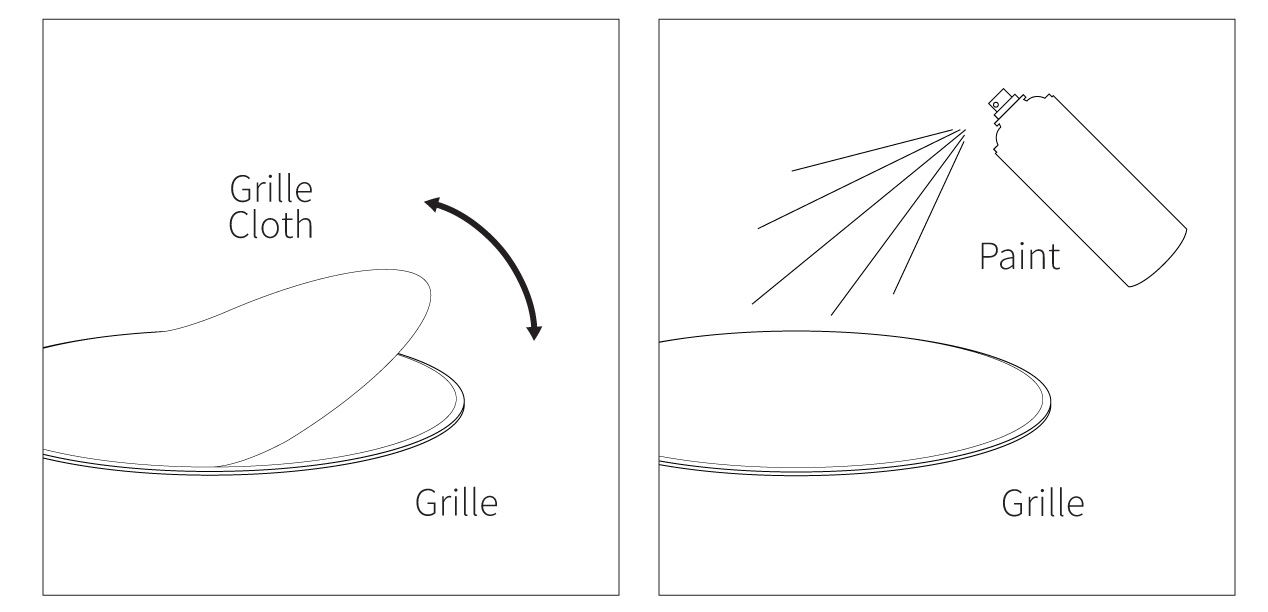
Cutting the Hole
When you’ve decided on the locations for all of the speakers, use the template to trace a circle lightly in pencil where the hole should be. (If you don’t have a template, check the Specifications section for cutout sizes.) If you’re unsure on whether there may be obstacles (such as pipes or wires) where you plan on installing the speaker, drill a ⅛ inch hole in the center of the circle, then put a bent coat hanger through the hole to feel around. Use a keyhole or drywall saw to cut the hole.
Installing the Bayonet Ring
Adjust the clips so that they’re positioned at the top of the rail. If they’re not already there you can do this by pushing the metal release tabs on the inside of the rail and pulling the clips to the top of the rails. Insert the bayonet ring into the hole in the ceiling by gently bending the rails inward. Reach inside the bayonet ring and push the clips down so that the bayonet ring is firmly in place, but not too tight. If the bayonet ring needs to be removed, reach inside and push the release tabs to reset the clips The bayonet ring can now be taken out.
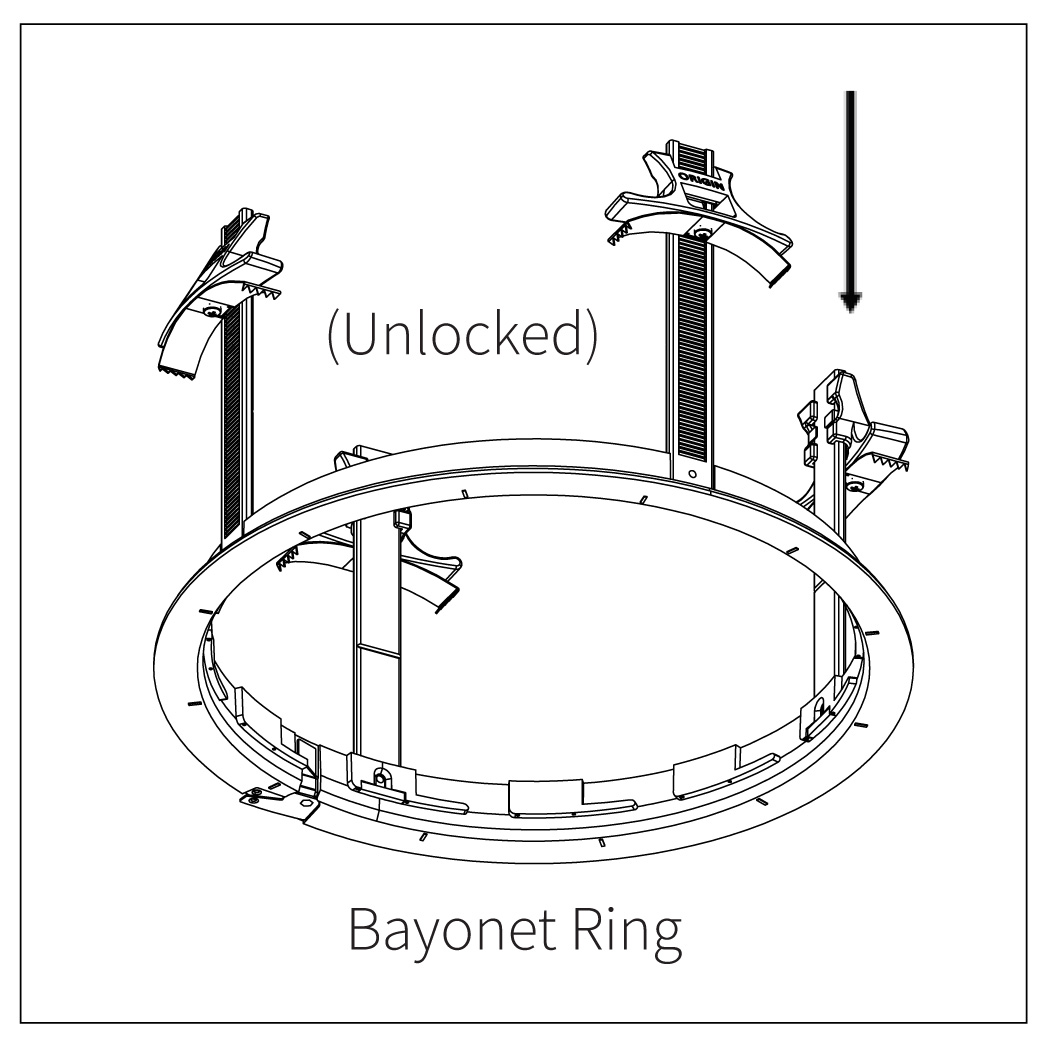

Connecting the Wire
To further maintain installation integrity, the Explorer collection uses screw-down Phoenix connector. Note the positive (+) and negative (-) indicators on the connector and make wire connections appropriate Ensure that the positive wire is being attached to the positive connection and the negative wire is being attached to the negative connection. If the negative and positive wires are switched, speaker performance will be drastically impacted.
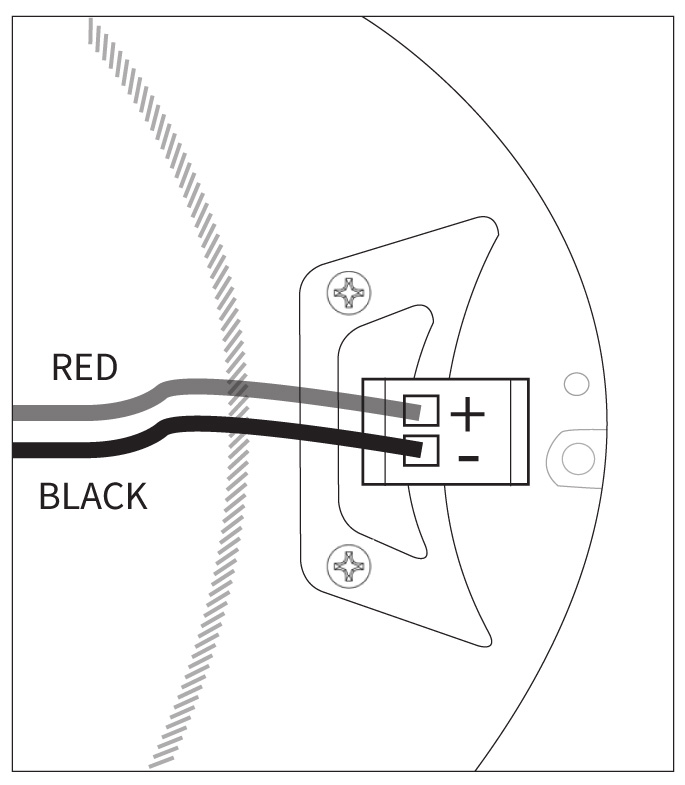
Installing the Speaker
Step 1.) Fit the loudspeaker into the bayonet ring. Then twist the speaker about 15 degrees clockwise into place. When the loudspeaker is properly seated, the indicators on the ring and the speaker will line up.
*Important* The indicators must line up to ensure the speaker is properly seated.
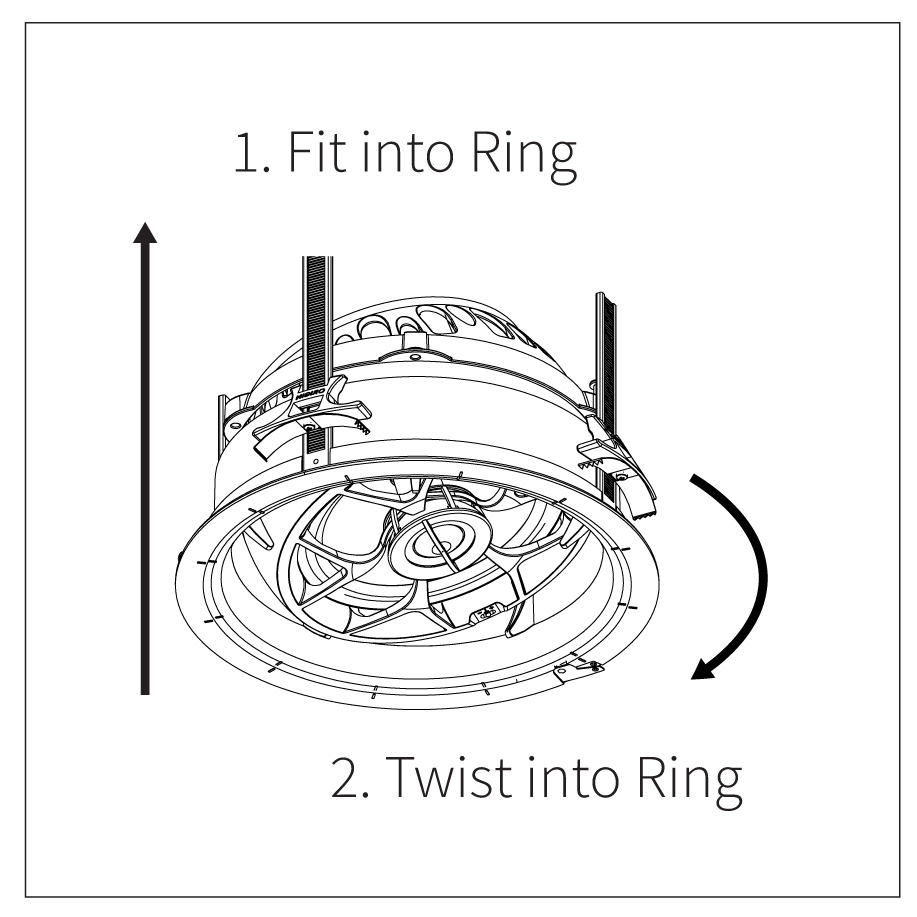
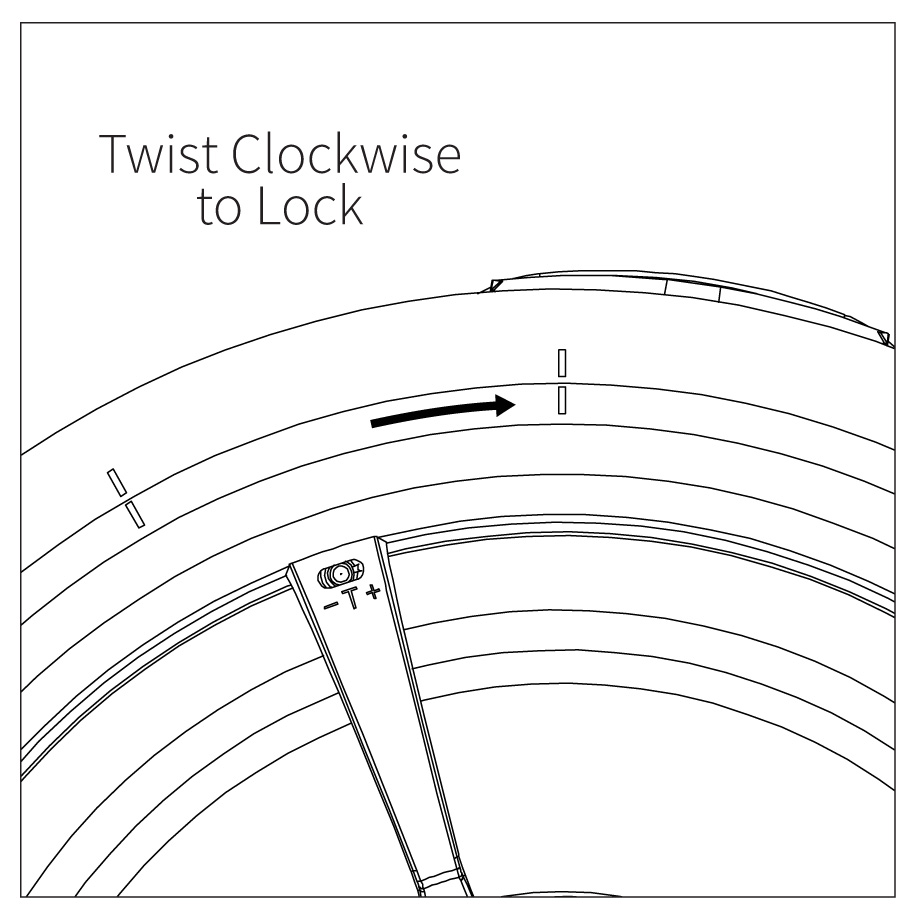
STEP 2.) THIS STEP DOES NOT APPLY FOR D105EX The bayonet ring also features a metal lock to ensure the correct installation of the loudspeaker. Out of the box, the lock will be in its closed position. Open the lock tab to its unlocked position to remove the speaker from the ring. Once the speaker is installed, close the lock tab by pushing it back into place, flush with the perimeter of the bayonet ring.
*Important* Push the metal lock tab into its “LOCK” (closed) position after speaker is installed per step 1. This will secure the installation. (See Figure A)
The loudspeaker must be properly seated, else the metal lock tab will not lock.
To uninstall the speaker, push the metal lock tab to its “UNLOCK” (open) position and twist the loudspeaker counterclockwise. (See Figure B)
| Figure A. | 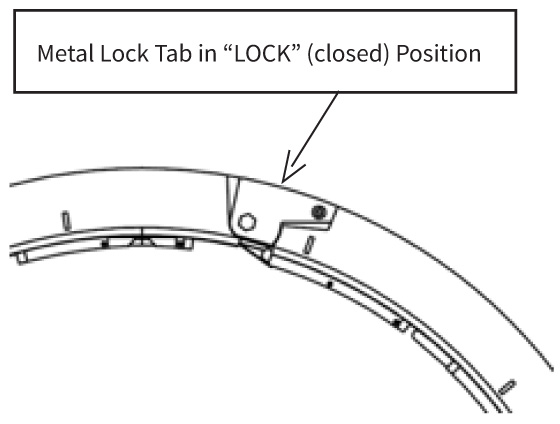 |
| Figure B. | 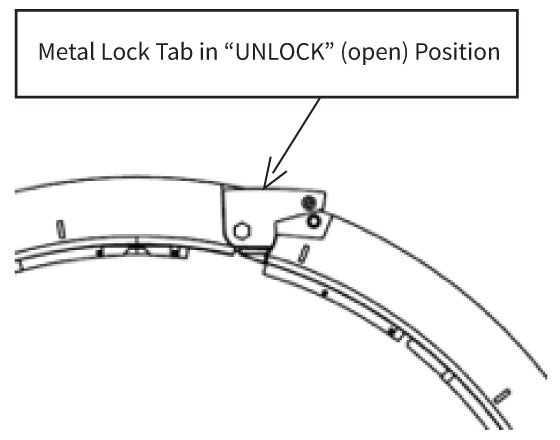 |
Silicone Sealant: In all applications where moisture is a concern, care should be taken to completely seal the speaker to the bayonet ring (Inner Border ‘A’) and also seal the bayonet ring to the installation surface (Outer Border ‘B’). It is strongly recommended that a liberal bead of marine grade silicone be applied in these two areas. This will improve weather resistance and also assure that mechanical vibrations, like those common in watercraft, will not dislodge the loudspeaker.
Testing & Adjustments
The midrange and tweeter can be pivoted to direct the sound towards the listen-ing area. Or for a more diffused surround sound experience, the rear speakers can be aimed towards the wall. To aim the tweeter, gently apply pressure to the rim with your thumbs to pivot the tweeter. To aim the midrange, gently apply pressure to the rim and pivot it in the desired direction. The D83A has a fixed angle. You should install the speaker with the baffle pointing toward the desired listening location. Subject to which speaker is being used, there are two switches: one to adjust the treble, and one to adjust the bass. When the room has a lot of hard surfaces bass & treble are bounced and reflected through the room. If the room has softer surfaces the bass & treble are absorbed. Adjust for the desired acoustic balance for each room.
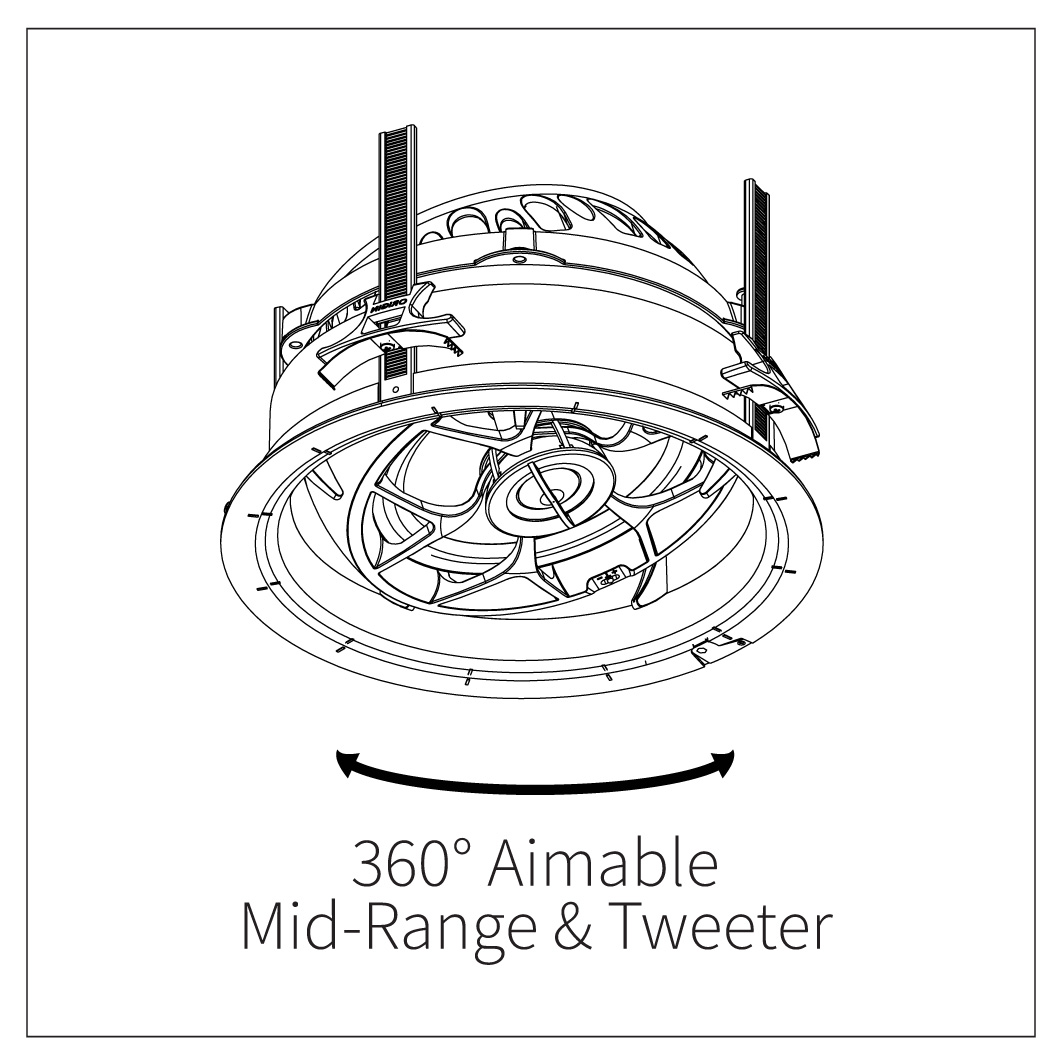
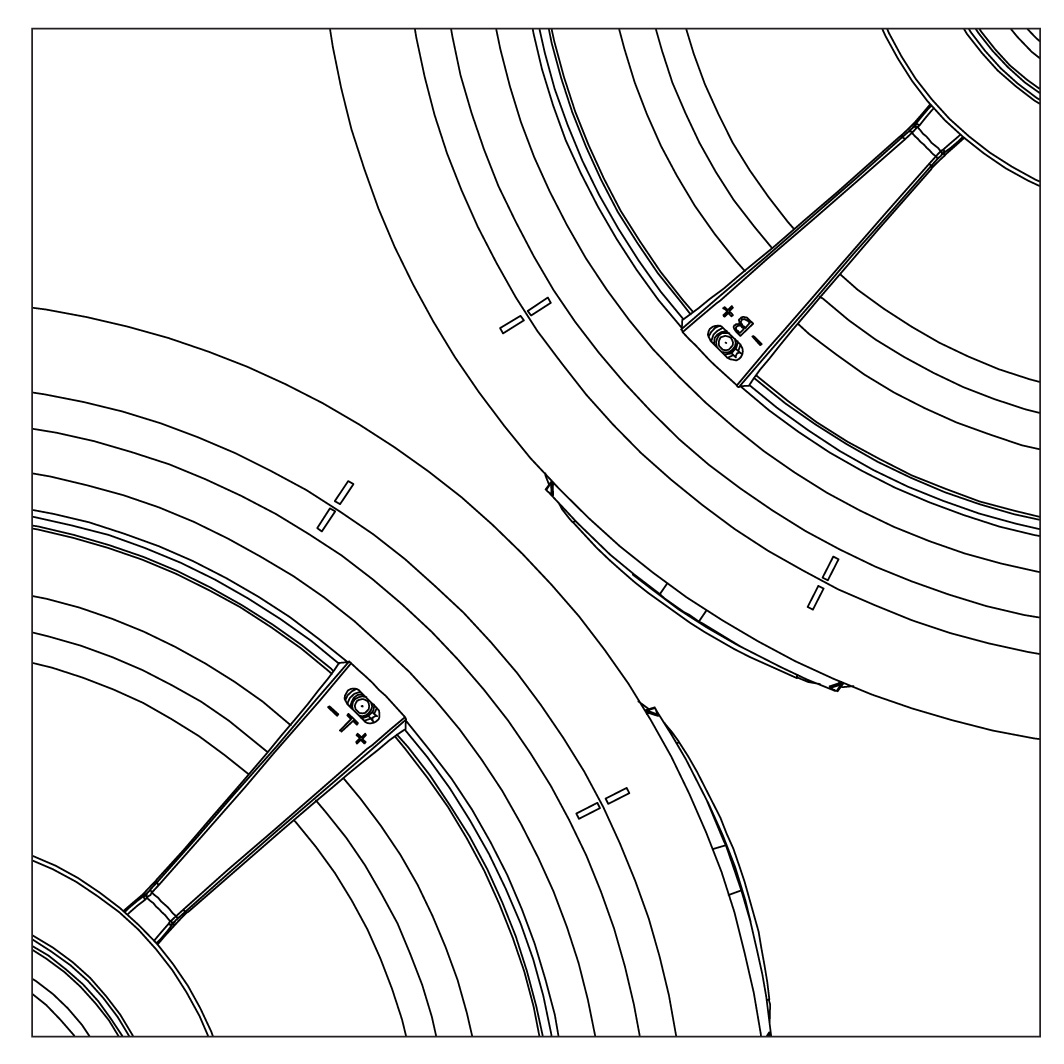
Installing the Grille
Fit the grille over the speaker. The grille uses magnets to be held in place.
Troubleshooting
If you have a problem, try isolating it first. For example, if you’re playing a DVD and there is no sound, try replacing the DVD with an MP3 player to see if you get sound. If it does work, then the problem is with the television, DVD player, or the cables connecting them. If it doesn’t work, the problem will be with the amplifier, speakers, or those cables.
Common Solutions
| PROBLEM | POSSIBLE CAUSES |
|---|---|
| NO SOUND | The volume may be turned down or muted. Check the volume settings volume may be turned down or muted. Check the volume settings on both the amplifier and the DVD player/ television/ computer/ etc. |
| NO SOUND | Make sure the proper source is selected on the amplifier or receiver. |
| NO SOUND | Check the cord connecting the amplifier with the source. The cord may be damaged or plugged into the wrong input or output. |
| NO SOUND | Check the wires connecting the amplifier with the speakers. Make sure they’re connected properly and not damaged in any way. |
| POOR SOUND QUALITY | If you hear something like static, or the sound is cutting in and out, check the audio cables. If the problem increases when a cable is being moved, then the cable is most likely faulty or not connected properly. |
| POOR SOUND QUALITY | Today’s audio systems may have several places to adjust the volume, for example your MP3 player may have a volume control, and your amplifier may also have one. Check to be certain that the volume isn’t turned up past 80% on any device. |
| POOR SOUND QUALITY | Try changing sources to be certain that the selection you’ve chosen is a good quality recording. |
Technical Assistance
If you have any questions or concerns about installing or using this product, you can reach us through one of the following methods:
Phone: (844) 674-4461
Hours of operation: 8:00am – 5:00pm (Pacific Time), Mon – Fri
Email: sales@originacoustics.com
If you are having technical trouble, please include the model number and briefly explain what steps you took to resolve the problem in your email, or be prepared to answer these questions over the phone. If you are considering returning the product, it’s required that you contact Origin Acoustics prior to any return attempts. This way we can determine if the issue can be resolved without returning the product, or if needed we can provide instructions and support for the return process.
Limited Lifetime Warranty
Origin Acoustics warrants to the original retail purchaser only that this Origin Acoustics product will be free from defects in materials and workmanship, provided the speaker was purchased from an Origin Acoustics authorized dealer.
If the product is determined to be defective, it will be repaired or replaced at Origin Acoustics’ discretion. If the product must be replaced yet it is no longer manufactured, it will be replaced with a model of equal to or greater value that is the most similar to the original. If this is the case, installing the replacement model may require mounting modifications; Origin Acoustics will not be responsible for any such related costs.
Requirements & Coverage
This warranty may not be valid if the product was purchased through an unauthorized dealer. This warranty only applies to the individual that made the original purchase, and it cannot be applied to other purchases. The purchaser must be prepared to provide proof of purchase (receipt). This warranty will not be valid if the identifying number or serial number has been removed, defaced, or altered.
Not Covered by Warranty
- Accidental damage
- Damage caused by abuse or misuse
- Damage caused by attempted repairs/modifications by anyone other than Origin Acoustics or an authorized dealer
- Damage caused by improper installation
- Normal wear, maintenance, and environmental issues
- Damage caused by voltage inputs in excess of the rated maximum of the unit
- Damage inflicted during the return shipment
Return Process
Before making any return attempts, it is required that you first contact Origin Acoustics. Return product to Origin Acoustics or your dealer, either in person or by mail. It’s preferable if the product is returned in the original packaging. If this isn’t possible, the customer is responsible for insuring the shipment for the full value of the product.
This warranty is in lieu of all other expressed or implied warranties. Some states do not allow limitations on implied warranties, so this may not apply depending on the customer’s location. (For more information, see Magnuson-Moss Warranty Act.)
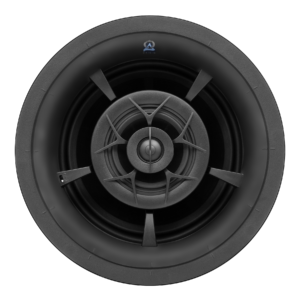
| D85EX | |
| Part: | SCD85000EX |
| Woofer: | 8” IMG |
| Midrange: | 4” IMG MMP |
| Tweeter: | 3/4” Aluminum MMP |
| Freq. Response (-10db): | 36Hz-20kHz |
| Power RMS: | 50W |
| Power Peak: | 150W |
| Impedance: | 6 ohm |
| Diameter: | 9 5/8” (244mm) |
| Cutout Diameter: | 8 3/4” (222mm) |
| Grille Diameter: | 10” (254mm) |
| Mounting Depth: | 5 5/8” (142mm) |
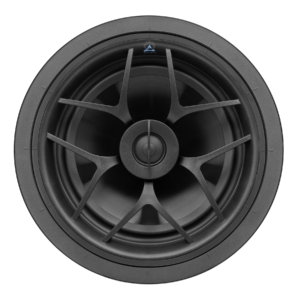
| D83EX | |
| Part: | DSC83000EX |
| Woofer: | 8” IMG |
| Midrange: | N/A |
| Tweeter: | 1″ Aluminum MMP |
| Freq. Response (-10db): | 38Hz-20kHz |
| Power RMS: | 50W |
| Power Peak: | 150W |
| Impedance: | 6 ohm |
| Diameter: | 9 5/8” (244mm) |
| Cutout Diameter: | 8 3/4” (222mm) |
| Grille Diameter: | 10” (254mm) |
| Mounting Depth: | 4 1/2” (114mm) |
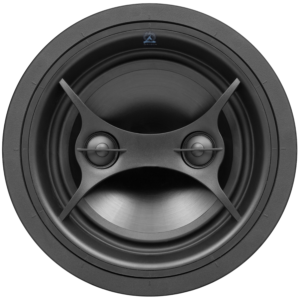
| D83DT/SUR EX | |
| Part: | SCDT83000EX |
| Woofer: | 8” IMG |
| Midrange: | N/A |
| Tweeter: | Dual 1” Aluminum MMP |
| Freq. Response (-10db): | 38Hz-20kHz |
| Power RMS: | 50W |
| Power Peak: | 150W |
| Impedance: | 6 ohm |
| Diameter: | 9 5/8” (244mm) |
| Cutout Diameter: | 8 3/4” (222mm) |
| Grille Diameter: | 10” (254mm) |
| Mounting Depth: | 4 1/4” (108mm) |

| D83AEX | |
| Part: | SCD85000EX |
| Woofer: | 8” IMG – Fixed Angle |
| Midrange: | N/A |
| Tweeter: | 1” Aluminum MMP |
| Freq. Response (-10db): | 38Hz-20kHz |
| Power RMS: | 50W |
| Power Peak: | 150W |
| Impedance: | 6 ohm |
| Diameter: | 9 5/8” (244mm) |
| Cutout Diameter: | 8 3/4” (222mm) |
| Grille Diameter: | 10” (254mm) |
| Mounting Depth: | 4 11/16”(119mm) |

| D65EX | |
| Part: | SCD85000EX |
| Woofer: | 6 1/2” IMG Pivoting |
| Midrange: | 4” IMG MMP |
| Tweeter: | 1” Aluminum MMP |
| Freq. Response (-10db): | 45Hz-20kHz |
| Power RMS: | 40W |
| Power Peak: | 150W |
| Impedance: | 6 ohm |
| Diameter: | 9 5/8” (244mm) |
| Cutout Diameter: | 8 3/4” (222mm) |
| Grille Diameter: | 10” (254mm) |
| Mounting Depth: | 5 1/4” (134mm) |
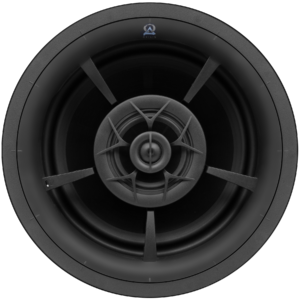
| D105EX | |
| Part: | SCD100500EX |
| Woofer: | 10” IMG |
| Midrange: | 4” IMG MMP |
| Tweeter: | 1” Aluminum MMP |
| Freq. Response (-10db): | 28Hz-20kHz |
| Power RMS: | 50W |
| Power Peak: | 150W |
| Impedance: | 6 ohm |
| Diameter: | 11 1/4” (286mm) |
| Cutout Diameter: | 10 3/8” (264mm) |
| Grille Diameter: | 11 21/32” (296mm) |
| Mounting Depth: | 6 7/32” (158mm) |